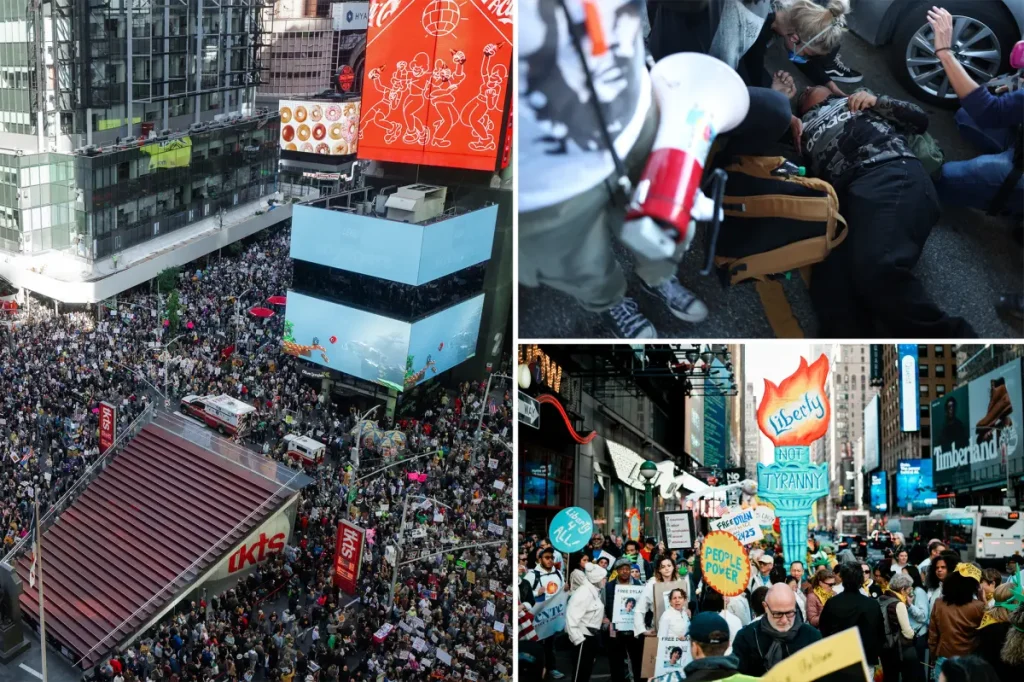Arrest and Unrest: Tensions Rise During “No Kings” Protests Across the US
In a concerning development amid nationwide “No Kings” demonstrations, David Cox, a 54-year-old man from Newark Valley, was arrested in New York City on Saturday on terrorism charges after allegedly making threats about attacking federal agents. According to police sources, Cox had boasted to a stranger at an Owego gas station that he possessed weapons in his trunk and intended to “fight ICE agents” at an upcoming Manhattan rally. The alarmed bystander reported this disturbing interaction to authorities after Cox departed from the gas station. The NYPD managed to locate Cox through a license plate reader system, apprehending him at approximately 2:25 PM as the Manhattan demonstration—which drew nearly 100,000 participants—was in full swing. Despite Cox’s claims, police reported finding no firebombs or weapons in his vehicle upon searching it. He now faces serious charges including making a terroristic threat, false reporting of terrorism, and making a threat of mass harm. This incident has heightened concerns about potential violence amid the already tense political climate.
The “No Kings” protests brought tens of thousands of demonstrators to the streets of Manhattan and other major cities across the United States on Saturday. These gatherings represented a collective expression of opposition to President Trump and several of his administration’s policies. Protesters carried signs with strong messages and chanted slogans calling for the president’s resignation. Many demonstrators directed particular criticism toward U.S. Immigration and Customs Enforcement (ICE), with some drawing controversial comparisons between the federal agency and the KKK. Despite the passionate nature of these demonstrations and the large turnout, Manhattan’s protests remained largely peaceful, with authorities reporting no arrests within the city itself. The demonstrations reflected growing political tensions in America and the increasingly polarized nature of public discourse surrounding immigration enforcement, presidential authority, and civil liberties. These peaceful demonstrations in New York stood in stark contrast to some of the more volatile scenes that would unfold elsewhere later that day.
As night fell, protests in several cities took a troubling turn toward violence and disorder. Portland, Oregon—which has been a flashpoint for immigration protests since June—saw federal authorities deploy tear gas against demonstrators after the situation deteriorated near a local immigration detention center. According to the Portland Police Bureau, at least three individuals were detained following an alleged assault during the downtown rally. The Portland protests have become particularly contentious, with recurring confrontations between demonstrators and law enforcement around immigration facilities becoming an almost regular occurrence in recent months. The city has struggled to maintain order amid competing protests from various political factions, with this latest incident representing another chapter in Portland’s ongoing struggle with political demonstrations and the appropriate response from authorities. The situation highlights the challenge faced by law enforcement in balancing the right to protest with maintaining public safety.
Simultaneously, similar scenes of unrest unfolded in the Chicago area, where Illinois state police arrested at least four protesters near an ICE facility in Broadview, approximately 10 miles from Chicago’s center. Disturbing footage captured the escalation as demonstrators wearing gas masks and helmets clashed with police after darkness fell. The confrontations near Chicago represent another example of how initially peaceful demonstrations evolved into more confrontational encounters as day turned to night. Meanwhile, in Los Angeles, the situation also intensified as police pursued protesters who had taken to the streets, resulting in at least one person being injured during the ensuing chaos. These incidents across multiple cities point to a pattern of daytime demonstrations giving way to more volatile situations after sunset, presenting significant challenges for both protest organizers hoping to maintain peaceful advocacy and law enforcement agencies tasked with maintaining public order.
The nationwide “No Kings” protests illustrate the deep divisions in American society regarding immigration policy, presidential authority, and the appropriate role of federal agencies like ICE. While many protesters exercised their First Amendment rights peacefully, the incidents in Portland, Chicago, and Los Angeles demonstrate how quickly such demonstrations can escalate into confrontation. The diverse responses from law enforcement across different cities—ranging from minimal intervention in Manhattan to tear gas deployment in Portland—reflect varying approaches to handling mass demonstrations. The protests also highlight how social and political tensions can manifest differently depending on local contexts, previous protest history, and relationships between communities and law enforcement agencies. As Americans continue to express strong opinions about national policies, the challenge remains finding ways to accommodate legitimate political expression while preventing dangerous escalations.
The arrest of David Cox stands out as particularly troubling amid this landscape of protest and counterprotest. Though no weapons were found in his possession, his alleged threats represent the kind of extremist rhetoric that can potentially inspire violence. His case serves as a reminder of the fine line between protected political speech and genuine security threats. As demonstrations continue across the country, law enforcement agencies face the difficult task of distinguishing between peaceful protesters, those engaged in civil disobedience, and individuals who may pose genuine threats to public safety. The “No Kings” protests, while largely peaceful in many locations, reveal the complex challenges facing a deeply divided nation struggling to find common ground on fundamental issues of governance, immigration, and presidential authority. As Americans exercise their right to assembly and free expression, the incidents across multiple cities serve as a sobering reminder of how fragile civic peace can be when political passions run high and rhetoric becomes increasingly inflammatory.


